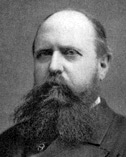Othniel Marsh was one of the towering figures in the early years of American paleontology. He discovered, described, and classified the fossils of many fossil vertebrates, including well-known dinosaurs such as Stegosaurus and Triceratops. Marsh was an early adherent of Charles Darwin’s theory of evolution and his enormous fossil collection allowed him to demonstrate a evolutionary link between birds and dinosaurs, and to trace the fifty-million year development of horses from Eohippus to the modern Equus.
During the late 1800’s, when the field of paleontology was still young and wide-open, Marsh developed a bitter rivalry with fellow paleontologist Edward Drinker Cope. Both men were extremely competitive; they spied on each other, hid or allegedly sabotaged bone fields, and attacked one another in scientific journals and in the press. This twenty-five year feud became known as the Bone Wars.
Marsh spent his academic career at Yale University where he led the first Yale Scientific Expeditions into the west and was the first professor of vertebrate paleontology. Marsh’s uncle was George Peabody, a wealthy and well-connected banker and merchant who funded Yale’s Peabody Museum of Natural History at Marsh’s request. Marsh was named one of the museum’s first curators and used his own money to enlarge the museum’s collections.
Marsh was President of the National Academy of Sciences in 1878 and 1879, ascending from the position of vice president, and more prominently from 1883 to 1895. During Marsh’s presidency he oversaw the strengthening of the academy’s financial position; the first issuances of the Henry Draper Medal, the James Craig Watson Medal, and the J. Lawrence Smith medal; and the regularization of the publication of papers presented at the Academy’s Annual Meeting. At congress’s request Marsh appointed a committee to analyze and improve the organization of the many geologic surveys and signal services then being funded by the government. The resultant report led congress to establish the U. S. Geological Survey under the Department of the Interior.



